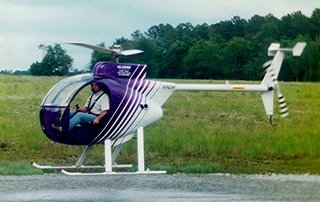
Helicopter
From Wikipedia, the free encyclopedia
which is lifted and propelled by one or more horizontal rotors. Helicopters are classified as rotary-wing aircraft to distinguish them from conventional fixed-wing aircraft. The word helicopter is derived from the Greek words helix (spiral) and pteron (wing). The first functional helicopter was created by Jan Bahyl in year 1901 of the basis of his patent from
Compared to conventional fixed-wing aircraft, helicopters are much more complex, more expensive to buy and operate, and are more limited in speed, range, and payload. The compensating advantage is maneuverability: helicopters can hover in place, reverse, and above all take off and land vertically. Subject only to refueling facilities and load/altitude limitations, a helicopter can travel to any location, and land anywhere with enough space (approximately twice the area of the rotor disk).
Compared with other vertical lift aircraft like tiltrotors (V-22 Osprey for example) and vectored thrust airplanes (AV-8 Harrier for example), helicopters are very efficient, carrying more than twice the payload, consuming less fuel in hover and costing considerably less to buy and operate. However these other configurations have a much higher cruise speed than a helicopter (270 km/h for a helicopter, 460 km/h for a tiltrotor, 900+ km/h for a vectored thrust airplane).
Helicopter models and identification
In identifying helicopters during flight it is helpful to know that when viewed from below, the rotor of a French, Russian, or Soviet designed helicopter rotates counter-clockwise, whilst that of a helicopter built in
Further information: List of helicopter models
Some companies, notably Schweizer Aircraft Corporation in the
Hybrid types that combine features of helicopters and fixed wing designs include the experimental Fairey Rotodyne of the 1950s and the Bell Boeing Osprey, which is on order by the U.S. Marine Corps and will be the first mass produced tiltrotor aircraft to enter service.
A helicopter should not be mistaken for an autogyro, which is a predecessor of the helicopter, that gains lift from an unpowered rotor.
Some common nicknames for helicopters are "copter", "chopper", "whirlybird", "windmill", "helo" (common U.S. Navy usage) or "paraffin Budgie" (the latter term being mostly used in the UK offshore oil industry).
Helicopters are useful for landing in tight spaces.
Many companies have helicopters for transport.
src="http://pagead2.googlesyndication.com/pagead/show_ads.js">





No comments:
Post a Comment